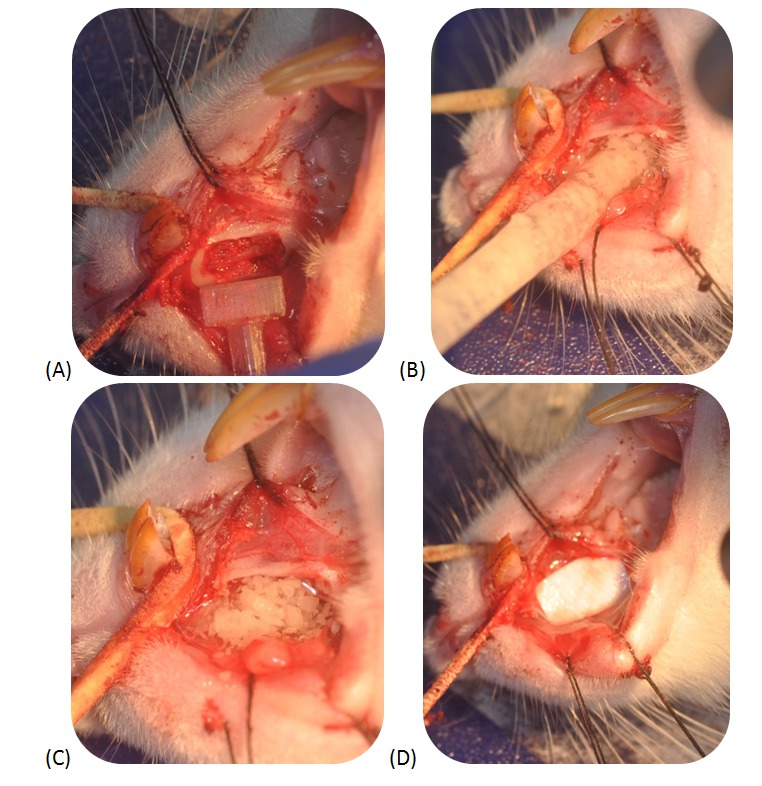IADR Abstract Archives
Autologous Adipose Tissue Derived MSCs for the Treatment of Alveolar Cleft Defect – The Feasibility of 3D µCT Evaluation
Objectives: µCT is considered a powerful tool to characterized bone tissue regeneration. Mesenchimal stromal cells originated from autologous adipose tissue can be seeded on a mineral scaffold in a gel-like consistency forming an 'injectable' bone. In this study, the implantation potential adipose tissue originated 'injectable' bone was evaluated in a bony defect, imitating a cleft palate using µCT in a rat model.
Methods: Critical-size alveolar cleft defect was surgically created in seven Sprague-Dawley rats. Treatment groups included alveolar cleft negative control, mineralized cortical bone scaffold and mineralized cortical bone scaffold seeded with autologous adipose tissue derived MSCs. Bone volume fraction (BV/TV) was characterized using µCT evaluation model at 6 weeks post-surgery. A bony defect contour was performed using three constant anatomical points of the rat's maxilla of the control group. The average contoured defect was finally used to standardize bony defect dimensions. The newly regenerated bone in the control group was compared to the experimental group using a micro-scale model comparing both sides of the given animal. Differences were correlated with histological analysis evaluation.
Results: New bone formation was calculated as the ratio of the bony fraction [bone volume (BV) divided by total volume (TV)] of the defect side relative to that of the untreated control side, that is, (BVDefect/TVDefect)/(BVControl/TVControl). Preliminary statistical evaluation revealed that untreated animals formed 15.4%, 14.1% and 9.1% new bone in the defect side while treated animals formed 33.6%, 31.6%, 30.1% and 21.1% new bone in the defect side. µCT evaluation showed intensive bone gain of 42% although the quantitative measurement of bone volume did not demonstrate a statistically significant difference in the treated animals.
Conclusions: New Bone formation can be quantified by the CT-based model quantification. Increasing the number of tested animals in the study groups and keeping a constant defect dimension may contribute to quantification accuracy.
Methods: Critical-size alveolar cleft defect was surgically created in seven Sprague-Dawley rats. Treatment groups included alveolar cleft negative control, mineralized cortical bone scaffold and mineralized cortical bone scaffold seeded with autologous adipose tissue derived MSCs. Bone volume fraction (BV/TV) was characterized using µCT evaluation model at 6 weeks post-surgery. A bony defect contour was performed using three constant anatomical points of the rat's maxilla of the control group. The average contoured defect was finally used to standardize bony defect dimensions. The newly regenerated bone in the control group was compared to the experimental group using a micro-scale model comparing both sides of the given animal. Differences were correlated with histological analysis evaluation.
Results: New bone formation was calculated as the ratio of the bony fraction [bone volume (BV) divided by total volume (TV)] of the defect side relative to that of the untreated control side, that is, (BVDefect/TVDefect)/(BVControl/TVControl). Preliminary statistical evaluation revealed that untreated animals formed 15.4%, 14.1% and 9.1% new bone in the defect side while treated animals formed 33.6%, 31.6%, 30.1% and 21.1% new bone in the defect side. µCT evaluation showed intensive bone gain of 42% although the quantitative measurement of bone volume did not demonstrate a statistically significant difference in the treated animals.
Conclusions: New Bone formation can be quantified by the CT-based model quantification. Increasing the number of tested animals in the study groups and keeping a constant defect dimension may contribute to quantification accuracy.



